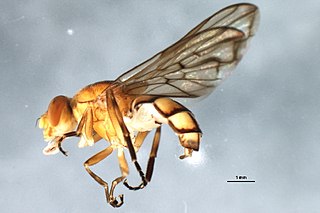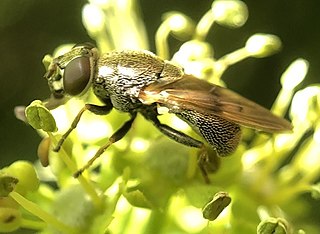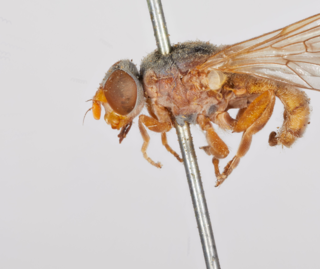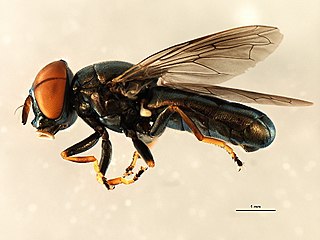
Hover flies, also called flower flies or syrphid flies, make up the insect family Syrphidae. As their common name suggests, they are often seen hovering or nectaring at flowers; the adults of many species feed mainly on nectar and pollen, while the larvae (maggots) eat a wide range of foods. In some species, the larvae are saprotrophs, eating decaying plant and animal matter in the soil or in ponds and streams. In other species, the larvae are insectivores and prey on aphids, thrips, and other plant-sucking insects.

The Tachinidae are a large and variable family of true flies within the insect order Diptera, with more than 8,200 known species and many more to be discovered. Over 1,300 species have been described in North America alone. Insects in this family commonly are called tachinid flies or simply tachinids. As far as is known, they all are protelean parasitoids, or occasionally parasites, of arthropods, usually other insects. The family is known from many habitats in all zoogeographical regions and is especially diverse in South America.

'Brachyopa notata , the Black-banded Sapeater , is a rare species of syrphid fly. It has been observed in Northeastern North America. Hoverflies get their names from the ability to remain nearly motionless while in flight. The adults are also known as flower flies for they are commonly found around and on flowers from which they get both energy-giving nectar and protein rich pollen. Larvae for this genus are of the rat-tailed type. B.notata larvae have not been described.

Myolepta strigilata, the Scaled Pegleg, is an uncommon species of syrphid fly observed in the eastern and central United States. Hoverflies can remain nearly motionless in flight. The adults are also known as flower flies for they are commonly found on flowers, from which they get both energy-giving nectar and protein-rich pollen. The larvae of this genus have been found in rot holes of deciduous trees.
Spilomyia crandalli, Crandall's Hornet Fly, is a rare species of syrphid fly first officially described by Curran in 1951. This species is found in western North America near the Pacific coast. Hoverflies get their names from the ability to remain nearly motionless while in flight. The adults are also known as flower flies for they are commonly found around and on flowers, from which they get both energy-giving nectar and protein-rich pollen. The larvae are known as the short-tailed larvae, suited for moist areas such as rot holes of trees.
'Brachyopa gigas (Lovett, 1882), the Giant Sapeater, is a rare, species of syrphid fly. It has been observed in Washington state and California. Hoverflies get their names from the ability to remain nearly motionless while in flight The adults are known as flower flies for they are commonly found around and on flowers from which they get both energy-giving nectar and protein-rich pollen. Larvae for this genus are of the rat-tailed type. B.gigas larvae have not been described.

Temnostoma balyras , the Yellow-haired Falsehorn , is a common species of syrphid fly observed in the eastern half of the United States and adjacent areas of Canada. Hoverflies can remain nearly motionless in flight. The adults are also known as flower flies for they are commonly found on flowers, from which they get both energy-giving nectar and protein-rich pollen. Larvae burrow in moist decayed wood using their hooks as rasping organs operated in a forwards and backwards motion by huge muscles housed in the mesothorax and metathorax. The larvae of T.balyras have been described by Heiss in "A classification of the larvae and puparia of the Syrphidae of Illinois exclusive of aquatic forms".

Orthonevra pulchella (Williston 1887) the Dusky Mucksucker is a fairly common species of syrphid fly. It has been observed from across northern North America. Hoverflies get their names from the ability to remain nearly motionless while in flight. The adults are also known as flower flies for they are commonly found around and on flowers, from which they get both energy-giving nectar and protein-rich pollen. Larvae for this genus are of the rat-tailed type. O. pulchella larvae have not been described.

Spilomyia liturata, the Rocky Mountain Hornet Fly, is an uncommon species of syrphid fly. This species is found in western North America along the Rocky Mountains. Hoverflies get their names from the ability to remain nearly motionless while in flight. The adults are also known as flower flies for they are commonly found around and on flowers, from which they get both energy-giving nectar and protein-rich pollen. The larvae are known as the short-tailed larvae, suited for moist areas such as rot holes of trees.

'Eristalis saxorum, the Blue-polished Drone Fly, is an uncommon species of syrphid fly found along the Eastern United States. Hoverflies get their names from the ability to remain nearly motionless while in flight. The adults are also known as flower flies for they are commonly found around and on flowers, from which they get both energy-giving nectar and protein-rich pollen. The larvae are aquatic filter-feeders of the rat-tailed type. The larvae of this species have not been identified. Little is known about this uncommon species which flies from mid-March to late October.
Brachyopa perplexa , The Hairy-striped Sapeater, is an uncommon species of syrphid fly. It has been observed from the Appalachian Mountains to New York and Quebec, Canada. Hoverflies get their names from the ability to remain nearly motionless while in flight. The adults are also known as flower flies, for they are commonly found around and on flowers, from which they get both energy-giving nectar and protein-rich pollen. Larvae for this genus are of the rat-tailed type. B.perplexa larvae have not been described.

Brachyopa media ( Williston, 1882), is a rare species of syrphid fly. It has been observed in the Northeastern United States. Hoverflies get their names from the ability to remain nearly motionless while in flight. The adults are also known as flower flies for they are commonly found around and on flowers from which they get both energy-giving nectar and protein-rich pollen. Larvae for this genus are of the rat-tailed type. B.media larvae have not been described.
Brachyopa rufiabdominalis , the Red-tailed Sapeater, is a rare species of syrphid fly. It has been observed in Colorado. Hoverflies get their names from the ability to remain nearly motionless while in flight. The adults are also known as flower flies, for they are commonly found around and on flowers from which they get both energy-giving nectar and protein-rich pollen. Larvae for this genus are of the rat-tailed type. B.rufiabdominalis larvae have not been described.

Orthonevra anniae (Sedman, 1966), the shiny-sided mucksucker, is a rare species of syrphid fly. It has been observed in Northeastern North America. Hoverflies get their names from the ability to remain nearly motionless while in flight. The adults are also known as flower flies for they are commonly found around and on flowers, from which they get both energy-giving nectar and protein-rich pollen. Larvae for this genus are of the short tailed rat-tailed type. O. anniae larvae have not been described.

Orthonevra feei, Fee's mucksucker, is a rare species of syrphid fly. It has been observed only in New Hampshire, United States. Hoverflies get their names from the ability to remain nearly motionless while in flight. The adults are also known as flower flies, for they are commonly found around and on flowers from which they get both energy-giving nectar and protein-rich pollen. Larvae for this genus are of the rat-tailed type. O. feei larvae have not been described.
Cheilosia caltha, the prairie blacklet, is a fairly common species of syrphid fly observed across North America. Hoverflies can remain nearly motionless in flight. The adults are also known as flower flies for they are commonly found on flowers from which they get both energy-giving nectar and protein rich pollen. Larvae, when known, are plant feeders.
Hammerschmidtia rufa, the black-bristled logsitter, is an uncommon species of syrphid fly observed across North America. Hoverflies can remain nearly motionless in flight. The adults are also known as flower flies for they are commonly found on flowers from which they get both energy-giving nectar and protein-rich pollen. Larvae have been found under bark of aspen, elm, walnut, and willow. Described as Hammerschmidtia ferruginea by Curran.
Eupeodes pomus, the short-tailed aphideater, is a species of syrphid fly observed across North America. Hoverflies can remain nearly motionless in flight. The adults are also known as flower flies for they are commonly found on flowers from which they get both energy-giving nectar and protein-rich pollen. Larvae have been reported feeding from various aphids.
Heringia rita, the black-faced spikeleg, is a common species of syrphid fly observed in many locations across North America. Hoverflies can remain nearly motionless in flight. The adults are also known as flower flies for they are commonly found on flowers, from which they get both energy-giving nectar and protein-rich pollen. Larvae have been reared from Adelges piceae and Eriosoma lanigerium.
Trichopsomyia banksi ,the white-faced psyllid killer, is an uncommon species of syrphid fly observed across North America. Hoverflies can remain nearly motionless in flight. The adults are also known as flower flies for they are commonly found on flowers from which they get both energy-giving nectar and protein-rich pollen. Larvae are unknown but other members of this genus are psyllid, aphid and Phylloxera predators.










